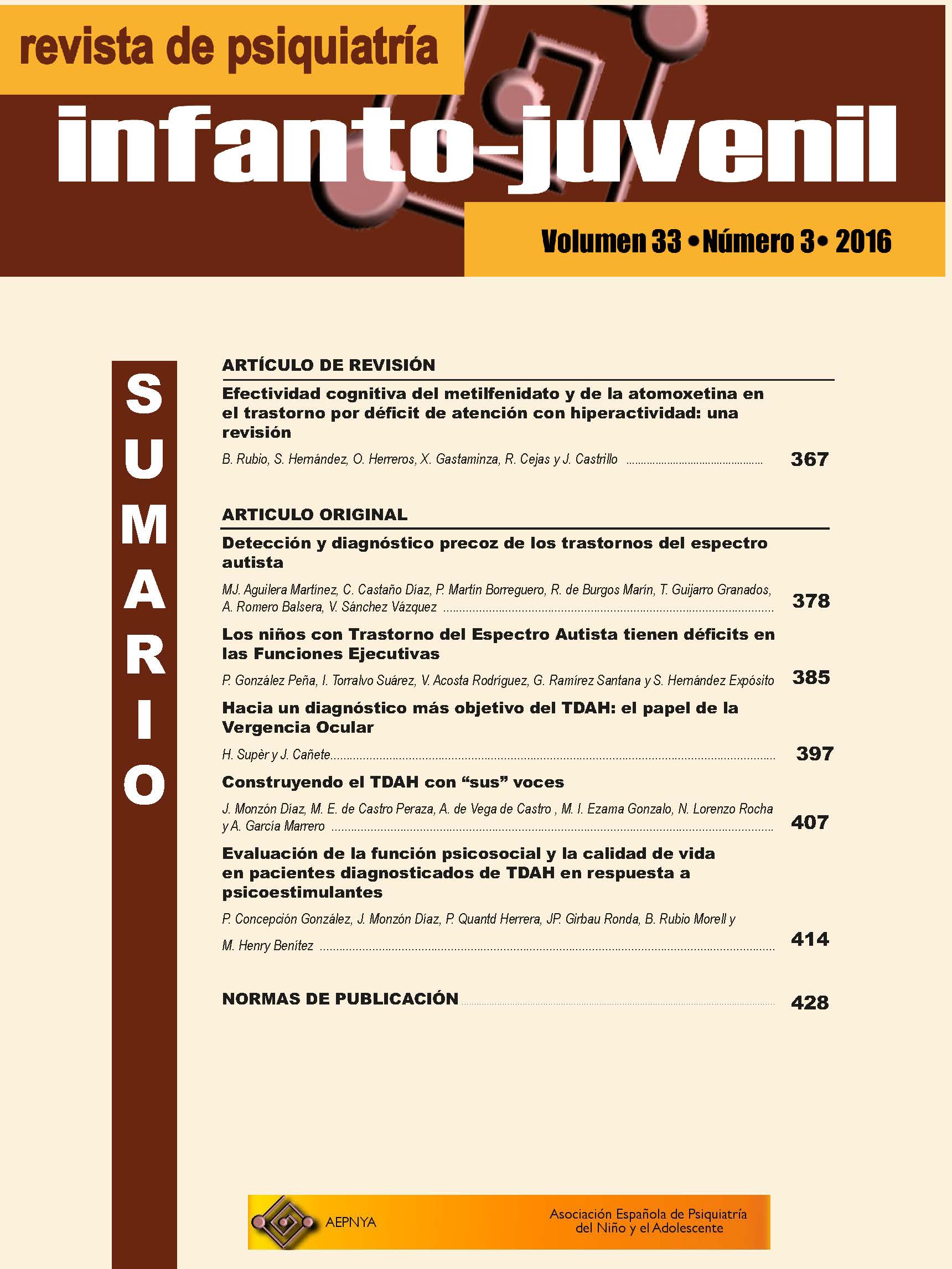Los niños con Trastorno del Espectro Autista tienen déficits en las Funciones Ejecutivas
Descargas
Publicado
Cómo citar
Número
Sección
DOI:
https://doi.org/10.31766/revpsij.v33n3a3Palabras clave:
Funciones ejecutivas, Atención, Velocidad de procesamiento, Trastorno del Espectro Autista, Evaluación neuropsicológicaResumen
Existe un creciente acuerdo científico sobre el hecho de que en personas con Trastorno del Espectro Autista (TEA) se identifican alteraciones neurológicas de considerable magnitud que tienen una base genética que se expresa en el desarrollo neuronal. Como consecuencia de esto se han identificado déficits en funciones cognitivas complejas en esta población, si bien los resultados hasta el momento son inconsistentes. El objetivo de nuestro trabajo ha sido la caracterización neuropsicológica de una población con TEA. Para ello, a una muestra de 18 niños diagnosticados con TEA, le hemos administrado una batería neuropsicológica amplia destinada a la evaluación de la atención y de las funciones ejecutivas. Los resultados obtenidos por el grupo experimental fueron contrastados con los alcanzados por una muestra de 18 niños con desarrollo típico. En ellos se muestra como el grupo con TEA tiene un déficit generalizado en atención y funciones ejecutivas, excepto en fluidez verbal con claves semánticas, planificación y flexibilidad cognitiva. Se requiere más investigación para clarificar la naturaleza de estos hallazgos.
Descargas
Citas
2. Baddeley A. Working memory. Oxford: Clarendon Press; 1986.
3. Barkley RA, Fischer M. Predicting impairment in major life activities and occupational functioning in hyperactive children as adults: self reported executive function (EF) deficits versus EF tests. Dev Neuropsychol 2011; 36: 137-161.
4. Baron-Cohen S. Social cognition and pretend play in autism. (Tesis Doctoral). Departamento de Psicología, University College, London; 1985.
5. Baron-Cohen S, Pulvermüller F, Moseley RL, Correia MM, Shtyrov Y, Mohr B. Reduced volume of the arcuate fasciculus in adults with high-functioning autism spectrum conditions. Front Hum Neurosci 2016; 10; 214,1-15.
6. Belger A, Carpenter KLH, Yucel GH, Cleary KM, Donkers FCL. The neural circuitry of autism. Neurotox Res 2011; 20:201-214.
7. Benedet MJ, Alejandre MA. TAVECI: Test de aprendizaje verbal España-complutense infantil. Madrid: TEA Ediciones; 2001.
8. Benton AL, Hamsher K. Multilingual aphasia examination. Iowa city: University of Iowa; 1983.
9. Boucher J, Lewis V. Generativity in the play of young people with autism. J Autism Dev Disord 1995; 25:2, 105-121.
10. Boyd BA, McBee M, Holtzclaw T, Baranek GT, Bodfish JW. Relationships among repetitive behaviors, sensory features and executive functions in high functioning autism. Res Autism Spectr Disord 2009; 3:959–966.
11. Centers for Disease Control and Prevention (CDC) [en línea]. Community report on autism 2016. <a href="http://www.cdc.gov/mmwr" target="_blank">http://www.cdc.gov/mmwr</a> [Consulta: may. 2016].
12. Chan AS, Cheung M, Han YMY, Sze SL, Leung WW, Man HS, To CY. Executive function deficits and neural discordance in children with autism spectrum disorders. Clin Neurophysiol 2009; 120:1107-1115.
13. Chang YS, Owen JP, Desai SS, Hill SS, Arnett AB, Harris J, Marco E, Mukherjee P. Autism and sensory processing disorders: Shared white matter disruption in sensory pathways but divergent connectivity in socialemotional pathways. PLoS One 2014; 9:7, 1-17.
14. Chapman NH, Nato AQ, Bernier R, Ankenman K, Sohi H, Munson J. et al. Whole exome sequencing in extended families with autism spectrum disorder implicates four candidate genes. Hum Genet 2015; 134:1055–1068.
15. Confederación Autismo España [en línea] <a href="http://www.autismo.org.es/sobre-los-TEA/trastorno-delespecto-del-autismo" target="_blank">http://www.autismo.org.es/sobre-los-TEA/trastorno-delespecto-del-autismo</a> [Consulta: may. 2016].
16. Dissanayake C, Macintosh KE. Annotation: The similarities and differences between autistic disorder and Asperger’s disorder: a review of the empirical evidence. J Child Psychol Psychiatry 2004; 45:3, 421-434.
17. Fama R, Sullivan EV, Shear PK, Cahn-Weiner DA, Yesavage JA, Tinklenberg JR, Pfefferbaum A. Fluency performance patterns in Alzheimer’s disease and Parkinson’s disease. Clin Neuropsychol 1998; 12, 487-499.
18. Frith U. Autism: Explaining the enigma. Oxford: Blackwell; 1989.
19. Geurts HM, Oosterlaan J, Roeyers H, Sergeant JA, Verté S. Executive functioning in children with autism spectrum disorder: Can we differentiate within the spectrum? J Autism Dev Disord 2006; 36:3, 351-372.
20. Geurts HM, Booth R, Happé F, Sinzing J. Neuropsychological heterogeneity in executive functioning in autism spectrum disorders. Int J Dev Disabil 2014, 60:3, 155-162.
21. Goldberg MC, Mostofsky SH, Cutting LE, Mahone EM, Astor BC, Denckla MB, Landa RJ. Subtle executive impairment in children with autism and children with ADHD. J Autism Dev Disord 2005; 35:3, 279-293.
22. Harris AJ (1947). Test of lateral dominance. New York. Psychological Corporation 1947. Test de dominancia lateral. Madrid. TEA Ediciones, S.A.; 1978.
23. Kaufman A, Kaufman N. Test breve de inteligencia de Kaufman (K-BIT). Madrid: TEA Ediciones; 2000.
24. Kenworthy L, Black DO, Harrison B, della Rosa A, Wallace GL. Are executive control functions related to autism symptoms in high-functioning children? Child Neuropsychol 2009; 15: 425-440.
25. Koechlin E, Basso G, Pietrini P, Panzer S, Grafman J. The role of the anterior prefrontal cortex in human cognition. Nature 1999; 399, 148-151.
26. Korkman M, Kirk U, Kemp S. Batería de evaluación neuropsicológica NEPSY, a developmental neuropsychological assessment. Madrid: Pearson; 1998.
27. Lezak MD, Howieson DB, Loring DW. Neuropsychological assessment (4ª ed.) Oxford University Press; 2004.
28. Lhermite F. “Utilization behaviour” and its relation to the lesions of the frontal lobes. Brain 1983; 106, 237-255.
29. Luria AR. The working brain. Middlesex: Penguin Books; 1973.
30. Martos-Pérez J, Paula-Pérez I. Una aproximación a las funciones ejecutivas en el trastorno del espectro autista. Rev Neurol 2011; 52:1, 147-53.
31. Oerlemans AM, Droste K, van Steijn DJ, de Sonneville LMJ, Builtelaar JK, Rommelse NNJ. Cosegregation of social cognition, executive function and local processing style in children with ASD, their siblings and normal controls. J Autism Dev Disord 2013; 43:2764-2778.
32. Oliveras-Rentas RE, Kenworthy L, Roberson RB, Martin A, Wallace G. WISC-IV profile in highfunctioning autism spectrum disorders: Impaired processing speed is associated with increased autism communication symptoms and decreased adaptive communication abilities. J Autism Dev Disord 2012; 42:655–664.
33. Ornoy A, Weinstein-Fudim L, Ergaz Z. Prenatal factors associated with autism spectrum disorder (ASD). Reprod Toxicol 2015; 56:155-169.
34. Panerai S, Tasca D, Ferri R, Genitori V, Elia M. Executive functions and adaptative behaviour in autism spectrum disorders with and without intellectual disability. Psychiatry J 2014; 1-11.
35. Pellicano E. Individual differences in executive function and central coherence predict developmental changes in theory of mind in autism. Dev Psychol 2010; 46:2, 530-544.
36. Pennington BF, Rogers SJ, Bennetto L, Griffith EM, Reed DT, Shyu V. Validity tests of the executive dysfunction hypothesis of autism. En: Russell J. (Ed.), Autism as an executive disorder. Oxford: Oxford University Press; 1997. p. 143–178.
37. Rey A. Test de copia y reproducción de una figura compleja. Madrid: TEA Ediciones; 1987.
38. Reynolds CR, y Bigler ED. Test of memory and learning (TOMAL). Austin, TX: Pro-Ed; 1994.
39. Schuetze M, Park MT, Cho IYK, MacMaster FP, Chakravarty MM, Bray SL. Morphological alterations in the thalamus, striatum, and pallidum in autism spectrum disorder. Neuropsychopharmacology 2016; 1-11.
40. Sedó M. Test de los cinco dígitos. Madrid: TEA Ediciones; 2007.
41. Seijas R. Atención, memoria y funciones ejecutivas en los trastornos del espectro autista: ¿cuánto hemos avanzado desde Leo Kanner? Rev. Asoc. Esp. Neuropsiq. 2015; 35:127, 573-586.
42. Sigman M, Spence SJ, Wang T. Autism from developmental and neuropsychological perspectives. Annu Rev Clin Psychol 2006; 2:327-55.
43. Spek A, Schatorjé T, Scholte E, van Berckelaer-Onnes I. Verbal fluency in adults with high functioning autism or Asperger syndrome. Neuropsychologia 2009; 47:3, 652–656.
44. Spence SJ, Schneider MT. The role of epilepsy and epileptiform EEGs in autism spectrum disorders. Pediatr Res 2009; 65, 559-606.
45. Stuss DT, Alexander MP, Hamer L, Palumbo C, Dempster R, Binns M, Levine B, Izukawa D. The effects of focal anterior and posterior brain lesions on verbal fluency. J Int Neuropsychol Soc 1998; 4, 265-278.
46. Tsai PT. Autism and cerebellar dysfunction: Evidence from animal models. Semin Fetal Neonatal Med 2016; 1-7.
47. Travers BG, Bigler E, Tromp DPM, Alduru N, Froelich A, Ennis C et al. Longitudinal processing speed impairments in males with autism and the effects of white matter microstructure. Neuropyschologia 2014; 53, 137-145.
48. Van Eylen L, Boets B, Steyaert J, Wagemans J, Noens I. Executive functioning in autism spectrum disorders: influence of task and sample characteristics and relation to symptom severity. Child Adolesc Psychiatr 2015; 24:1399-1417.
49. Volkmar FR, Paul R, Klin A, Cohen D (Eds.). Handbook of autism and pervasive developmental disorders (3ª ed.). London: Ed. Wiley; 2005.
50. Wechsler D. Wechsler memory scale (WMS-III) (3ªed.). San Antonio, TX: The Psychological Corporation; 1997.
51. Wechsler D. Wechsler intelligent scale of children (WISC-IV) (4ª ed.). San Antonio, TX: Hacourt Assessment; 2007.









 © 2021 AEPNyA Todos los derechos reservados
© 2021 AEPNyA Todos los derechos reservados
